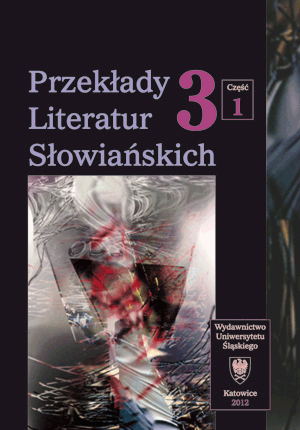Bariery kulturowe w przekładzie artystycznym na przykładzie słoweńskiego przekładu "Pana Tadeusza" Rozki Štefan
Cultural barriers in a literary translation on the basis of the Slovenian translation of "Pan Tadeusz" by Rozka Stefan
Author(s): Nikolaj JežSubject(s): Language and Literature Studies
Published by: Wydawnictwo Uniwersytetu Śląskiego
Keywords: Rozka Štefan; Pan Tadeusz in the Slovenian translation; Adam Mickiewicz; cultural barrier in the translation; metrics and versification in the translation
Summary/Abstract: On the one hand, the overview of the Slovene reception of Pan Tadeusz reveals typical cultural barriers which have marked the comprehension of the Polish Romantic Epic by the Slovene public, while on the other hand it also reveals that the tendency of Mickiewicz to distance himself from the style of High Romanticism brought the original, on its very publication, closer to the Slovene cultural tradition. The evaluation of the poem by Matija Čop, Slovene scholar and theoretician, has eliminated the barriers experienced by readers of the original and outlined a framework for the Slovene reception of Polish Romanticism, as well as creating a basis for the formation of a Slovene version of the Polish Romantic literary canon. In the Slovene environment, the awareness of barriers in the translation of Polish Romantic poetry has been focused mainly on the questions of metrics and versification. In her translation of the poem (1974), R. Štefan applied the principle of the substitution of thirteen-syllable verse with the syllabo-tonic iambic structure (with deviations in caesura and sound figures). Pan Tadeusz also constitutes a barrier on the levels of lexis and style; „Old Poland virtue” equivalents are manifest in the use of personal names, rhetorical figures, and in the naming of realia. For the most part, the translator preserved the original names, which, being anthroponyms, are functional but of a limited denotative value (Podkomornik, Vojski, Vozni). In selecting lexical equivalents, one observes in the translation a noticeable tendency towards lowering the status pertaining to the rural-country environment typical of the Slovene rural community. The principle of preserving the specifics of the original is respected to the extent permitted by the lexical and structural features of the Slovene language. The Polish name forms of the central characters acquire distinctive Slovene phonetic features (Tadej, Zosja, Matej, Gervazij), while the names of minor characters retain their original form (Rymsza). As a characteristic translation strategy, neutralisation is adopted in historical expressions related to the cultural model of Sarmatian nobility, having no translation equivalents in the target language. The translator aimed to resolve the cultural barriers in three ways: lexeme replacement, neutralisation of stylistically marked expressions, and preservation of original expressions.
Journal: Przekłady Literatur Słowiańskich
- Issue Year: 3/2012
- Issue No: 1
- Page Range: 63-74
- Page Count: 12
- Language: Polish

